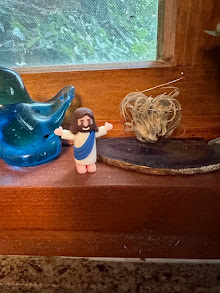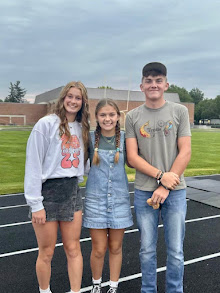
'Love's on sale tonight at this five and dime'.
Well, I was too young for romance back in the day when chopping dandelions earned a penny a pair. There was no allowance in our home, just chores and duties. All our needs were met; extra curricular efforts earned discretionary spending. We were expected to pick up the trash that blew into our yard every day; we were expected to clean the bathrooms twice the week and dust the furniture on Saturdays. We made our own beds, changed our own sheets, and put away our clothes. When we were younger, we were supposed to clean our room, but, like most kids, our version of clean and my dad's version of tidy did not see eye to eye. We assumed a clear path to walk to our beds was sufficient; when informed that the floor was to be picked up, we soon learned to stuff as much under the bed and into the closets as we could, ensuring no stray stuffed animal foot or Barbie dress protruded from its hiding place.
And we had lots of toys, many of our own creation. We were pack rats of sorts, collectors of objects peculiar and diverse. And to grow theses collections, we needed cash money.
Our room housed as many animals as Dr. Doolittle's menagerie, with skeletons of pipe cleaners and pelts of yarn. We made garages, bridges and highways with blocks and the latticed squares of the hooked rug in our room for our Matchbox vehicles. We built barns and corrals for the Breyer horses we loved as proxies for the real thing. We bounced Super balls against the metal closet doors and down the shiny tile hallway. We drove hard bargains for the baseball and football cards of our favorite players, the privileged cards chosen not so much for achievement on the field as face appeal on cardboard, though Redbirds and White Sox were most desired and frayed around the edges. We made jungles of fake flowers and vines not yet required by my mother's "antiquing" projects for the residence of slimy creepy crawlers of all colors and shapes.
All this took cash. Hard cash, not the paper kind. Paper money came in birthday cards and was immediately requisitioned and assigned for duty in our savings accounts. The idea of spending an actual five or ten dollar bill was unheard of. Frivolity was tolerated, but only in very small coinage.
As it turned out, the local stores had nearly everything we could ever need. Or afford, at any rate. Hawkins Five and Ten didn't have the name recognition of a Ben Franklin or a Woolworth or a Kresge, but it did have a couple of aisles of sewing supplies, including yarns in the colors we assigned the horsey hues of roan, palomino gold, bay brown and black. The sundries for pipe smokers were not out of our reach and a packet of short white pipe cleaners were just the right length for a pair of legs or a head, neck and body. We added girth to our horses' torsos with a Kleenex wrapped tightly around the intended body. When too much galloping, cantering and steeple chasing caused a break in some steed's leg, no euthanasia was necessary. Instead, yarn was unwrapped, a pipe cleaner prosthesis was twisted on and the pony went on to further adventures with nothing but some bulky "scar" tissue to indicate the operation. It took a lot of yarn to make our herd of 100 some horses. I wonder what the proprietors thought we were doing with our purchases. We finally ran out of names purloined from Walter Farley and Marguerite Henry books.
I don't remember if Hawkin's was our source for Matchbox cars, or if it was the Kosnar Walgreens next door. The selection would turn over from time to time. The little cars were not encased in plastic and cardboard back then as they are now. Rather, I remember looking at the little vehicles in their little "match" boxes through a glass showcase. They cost about 50 cents each, a perceived bargain even then. They had metal bodies and rubbery wheels. I loved the metallic colors, but the favored machines had doors or trunks or hoods that opened. Some of the cars even had springy axles, though that was more a feature on the newer fangled Hot Wheels. We bought Jaguars and Volkswagens, convertibles and concrete trucks, buses and tractors, all with a hint of glamour associated in our minds with these British imports.
I think we got our first Super balls as Christmas presents. The first ones were a pretty utilitarian hue of black or grayish green and about the size of a baseball. They were as amazing to us kids as our first Slinkies were....and just about as durable! Even with the best of intentions, a Slinky would become a bent and tangled puzzle in no time and we found our Super balls splitting in two like overripe watermelons. Their demise was crushing, but only temporarily so. Before long, knock off Super balls in every conceivable size and hue were available in the stores, but, more importantly, we could get them in gum ball machines.
Now my folks did not prohibit chewing gum. As a treat, we could have some Juicy Fruit or Wrigley's Spearmint now and then. But that gum came in packs from the store without the frisson of excitement of a gum ball dispenser. There was also the rare opportunity to blow bubbles, bigger and bigger, then suck them in just before they exploded in a thin gooey film all over your nose, lips, and chin. Bubble blowing was as impolite in our family as chewing gum with your mouth open; hence, bubble gum tended to be something we indulged in when my dad was at work.
But gum is ephemeral, a momentary pleasure. TOYS in a gum ball machine were thrilling, the kid's equivalent of gambling, for just a dime. Some of the wonders we purchased with our ten cents included, but were not limited to: the aforesaid superballs, tiny little multi-paged fat comics with one little cartoon a page, giant bubble rings of multi-hued translucent plastic, and creepy crawlers.
Obviously, the chemists were working overtime in the sixties. Maybe creepy crawlers were yet another offshoot of the wonders of NASA and the space program, but, whatever their origin, they were another collectible to the Renken girls. A machine full of creepy crawlers was a machine of mystery. The critters, whether flat two dimensional turtles, or lizards, or miniature alligators, or centipedes, or truly disgusting giant house flies, were all compressed into little capsules. Plink! went your dime into the slot and out popped a capsule with a critter ready to emerge from its chrysalis. Later, the toy makers marketed machines to make Creepy Crawlers, but these imitations lacked the requisite sliminess of the gumball animals. Before we were done collecting creepy crawlers, we discovered the wonders of fake fishing worms at Schleer's Hardware in Jeff City. At least once during each visit, my grandfather would go downtown to Schleer's to visit his buddies and Laura and I would ogle the fluorescent bait worms nestled in their gooey plastic beds. Never mind that these purchases would soon be covered in fuzz from the ditty bags my grandma made us for our treasures, until then they were colorful jewels in our trove.
These stores were not great emporiums, but it didn't take much to satisfy the longings of kids with literally a dime or two to their names. Our purchases were rationed by our funds, but we never considered them anything but a treat. I am pretty certain some of my old (and very very dog eared!) baseball cards are still in a box in the closet with old Barbie dolls and other tokens of bygone days. I remember the contents of the little cedar box that was my mom's: Missouri license plate key chains, tumbled stones in a little leather and fur bag, skeleton keys from assorted barns, sheds and old houses, skeins of embroidery thread, a handful of marbles. The trash and treasures of a childhood in love with the local five and dime.















No comments:
Post a Comment